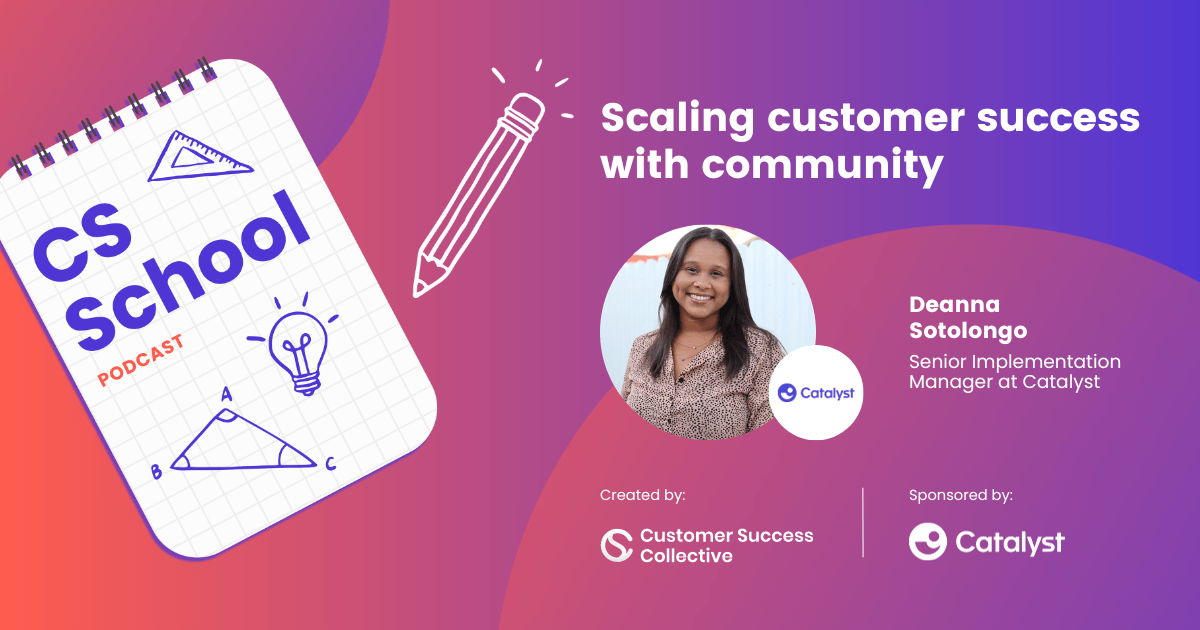This article was based on Bill's keynote presentation at Customer Success Festival in June 2021. You can catch up with this session and tons using our OnDemand service.
As the VP of Customer Success at Fluke Reliability, ensuring our customers achieve success with our software is my number one priority.
However, back in 2014-15 we realized many customers were buying our product but never actually getting started and implementing it correctly. Unfortunately, this led to low adoption, poor time-to-value, and higher churn rates. We knew our implementation process needed a major overhaul to drive better long-term outcomes.
So, how did we optimize our implementation process for long-term success?
In this article, I’m going to show you how we did just that at Fluke Reliability. Carry on reading if you want to learn:
- What our customer adoption crisis was that forced change
- Our solution
- How we optimized for scalability
- How you can streamline your implementation process
- How to standardize your implementation process across your team
- Why enhanced visibility can enable accountability
- How to sustain long-term success
- Why you should be perpetually optimizing your process
The customer adoption crisis that forced change
Back in 2014-15, our implementation services were an optional upsell during sales – customers could choose whether or not to purchase professional services for setup, training, and deployment.
At the time, this seemed like the customer-friendly option – we didn’t want to force services on those who didn't want them with a “hard sell.” But let it be known that the results left little to be desired.
Before 2015, we had optional implementation services that customers could buy, and the sales team could sell. But here’s the thing – they were optional. Looking back, that was a big mistake. And you know the numbers never lie – we saw less than a 20% attach rate for implementation services on new deals.
But here's where it got even worse (if you can believe it): customers who didn't purchase services often stalled out completely, never finishing implementation, and never realizing the value of the product they bought. Much of our churn was chalked up to this “never-getting-started” mentality.
We had no structured implementation process or ways to hold anyone accountable – the customer or our internal team. All of this increased the risk of churn due to lack of adoption. It was clearly not a sustainable trajectory for driving customer success and renewals.

The solution: Making implementation services mandatory
Realizing the magnitude of the problem, we made two critical shifts in our implementation approach:
- Implementation services became a required component bundled into every new deal and were no longer an optional add-on. With every sale, product, and new customer that comes on board, they're now required to have implementation services.
- We moved away from an open-ended hourly billing model to defined, fixed-scope implementation packages (four weeks, eight weeks, or 12 weeks in duration).
I certainly expected some pushback from our sales team on mandating services and increasing costs. However, we positioned it properly and saw zero decreases in terms of volume or percentage of sales. In fact, the required services actually increased our average deal sizes.
By taking this more heavy-handed approach, we drove accountability into the implementation process for both our customers and our internal team:
- Customers had to dedicate resources knowing services were mandated
- Our implementation specialists worked within a defined timeline instead of an open-ended hourly ramp
We wanted to get the customers. Not only do we want them to get on board and implement, but we want to get them there as fast as possible so they're seeing that return on investment as quickly as possible.

Optimizing for scalability
As our implementation team rapidly expanded from just a couple of people to eight or nine implementation specialists, we realized optimization would be critical for consistent, scalable delivery.
Customer journey gaps
Flashforward to 2018, we went through an extensive exercise to refine and document our implementation processes. The focus was really on the customer journey gaps. We realized we couldn't really take this to scale much further.
One of the first major steps, which became an ongoing best practice, was conducting a comprehensive mapping of the existing customer journey through our implementation process.
We mapped out their paths, and once they were on the whiteboard, we could visualize the full flow. That allowed us to walk through each step methodically and identify gaps, blockers, or disruptions that were negatively impacting the experience.
Visualizing the current state of the customer journey proved invaluable. Having it mapped out allowed us to take a critical, objective look at areas for optimization and improvement that weren't apparent when we were in the daily weeds. The journey mapping exercise surfaced issues we simply couldn't see otherwise.
From there, we dug deeper into the root causes of each gap or blockage to ideate and prioritize solutions for enhancing the overall implementation process. This has remained a crucial analysis we revisit regularly as customers' needs and processes evolve over time.
Visualizing the entire journey provides invaluable insights into areas for optimization. It surfaces gaps, blockers, and areas for improvement you may never see otherwise.

Streamlining implementation with a dedicated planner role
One of the major identified gaps was the amount of time our implementation specialists spent chasing and prepping customers before kicking off the hands-on technical work.
We realized this was a big gap that required us to get a planner scheduler in the door. The solution was creating a new dedicated Planner role to fully own all of those important pre-implementation responsibilities, including:
- Setting clear expectations and aligning on success criteria
- Ensuring customers had the right data, environments, and resources prepared
- Mapping out project plans and next steps for a smooth transition
This strategic shift allowed us to immediately recapture 20-30% of our implementers' time previously burned on these prep tasks. With that time refocused, our technical experts could concentrate on driving faster time-to-value through more hands-on deployment work - their core strength.
By aligning roles and responsibilities, we eliminated a significant bottleneck and accelerated customers' time-to-first value from our product. The Planner became the critical marriage between our sales and implementation teams.

Standardizing implementation processes across the team
With our quickly growing implementation team, it also became critical to standardize processes and methodologies through documented standard operating procedures (SOPs) that everyone followed.
We defined all of the steps. Everybody was bought in. And that doesn't start with just this team, right? It involves the whole company.
Having clear SOPs eliminates ambiguity and ensures reliable, consistent execution of the implementation process no matter who on the team is working on it. That way, there's no confusion around roles, responsibilities, handoffs, etc.
We got buy-in from other stakeholders, such as sales and marketing, upfront and made sure that everybody understood the strategy behind it. The change management aspect was relatively easy. This prevented territorial battles over responsibilities.
Enhanced visibility enables accountability
To enhance visibility and enable accountability, we centralized all of our implementation project tracking within Salesforce. Previously, we had been using siloed spreadsheets to manage team workloads, which limited transparency.
Centralizing this data into one system allowed us to:
- Eliminate silos: Everybody, including myself, whether you work in customer support, customer success, or an implementation team, should be able to go into an account record and see everything that's happening.
- Measure and optimize key metrics: You can't improve what you don't measure. We rigorously track key metrics around implementation efficiency, timelines, resource utilization, and more.
- Hold the team accountable: Just as a clean room is neat and free of clutter, a "clean-your-room” (CYR) dashboard would display data and metrics in a way that is uncluttered, well-structured, and conducive to efficient analysis. In order to make requests, your data needs to be shipshape and tidy.
"Remember when you were 10 years old, and you wanted to go out to play, but your mom told you to 'clean your room' first? This metaphor translates nicely to the business world, where before you can request something, your manager essentially asks, 'Did you clean your room?'
"The CYR dashboard represents the 'stick' in the 'carrot and stick' idiom, and you don't want to find yourself on this dashboard."
Having this transparency enabled us to identify and resolve bottlenecks far more effectively than working off siloed spreadsheets. We could see where we were hitting our target timelines and where we were frequently going over and needed to ramp up resources.
How to sustain long-term implementation success
While defining and documenting optimized processes was critical, we also focused on several higher-level factors to help sustain our implementation success over the long run.
Getting complete organizational alignment
As I emphasized, it all starts with us evangelizing this customer success mentality across the organization. You have to get buy-in from other teams, such as sales, marketing, support, professional services, etc.
I made sure my counterparts in other departments understood the "why" behind our new mandatory implementation approach. That early change management and communication helped ensure all teams were rowing in the same direction toward our customer success goals.
Continuously mapping the customer journey
The customer journey mapping exercise was invaluable and something we revisit regularly. Frequently mapping out the full customer journey provides invaluable insights into areas for continuous improvement.
Our customer's needs, processes, and priorities are constantly evolving. Maintaining a current understanding of their journey allows us to enhance implementation accordingly.

Rigorously documented standard operating procedures (SOPs)
While maintaining SOPs is an upfront investment, it pays out massive dividends by allowing you to effectively onboard and scale your implementation team over time.
As I mentioned earlier, having clear, documented SOPs eliminates miscommunication and ensures consistent execution no matter who is working on the implementation.
These documented processes become the backbone for reliable, high-quality service deliveries. At Fluke Reliability, we’re in the habit of updating our SOPs as processes and systems evolve.
Tracking and optimizing key implementation metrics
You can't optimize what you don't measure. We identified the key implementation metrics that mattered most to our business and customer success goals.
Consider the following questions:
- How successful are we in completing implementations within X weeks after starting?
- What is the average time spent on each implementation?
- Do certain employees excel with specific product types?"
Armed with these metrics, we could analyze where we hit our targets vs. falling short. We could identify bottlenecks, uncover training opportunities, and reallocate resources as needed to hit our standards.
We saw where we'd go over in four weeks, but in the eight-week spot, we'd hit almost 100% of the time. This allowed us to dig deeper into root causes and potential solutions.
%20(1).jpg)
Fostering an empathetic, customer-driven mindset
At the end of the day, your implementation and customer success teams must maintain unwavering alignment and partnership. It's easy for territoriality and silos to creep in if you aren't intentional:
Sometimes, building that empathy between the team members and the leaders is critical because it's very easy to become a “that's your job, that's my job” mentality. Ultimately, the customer loses in all of those situations.
We worked hard to foster an organizational culture of empathy and customer-centricity. Both teams deeply understood that our singular goal was making customers wildly successful. We were partners in driving value, not bickering over job roles.
I made sure our implementation and customer success managers maintained open communication, frequently collaborated on projects, and developed a mutual understanding of our processes and priorities. We were one customer success team with a relentless focus on exceptional customer outcomes.
Perpetual optimization: The journey toward customer success
Let me be clear: optimizing our implementation process was not an overnight fix but rather a perpetual journey of improvement over many years. We continuously analyzed our metrics, spoke with customers, pressure-tested our processes, and optimized accordingly.
We identified the need for change as we progressed from a rough process to a point where optimization became necessary three years later.
That cycle of analyzing, adjusting, measuring, refining, and optimizing is never over when your primary goal is ensuring customers can realize sustainable value from your products and services.
The payoff from treating implementation as an essential growth driver has been phenomenal:
- Increased customer product adoption and utilization
- Higher customer satisfaction scores
- Improved customer retention and expansion revenue
- Overall greater customer lifetime value

TL;DR
If you've started to realize your current implementation services and processes are inhibiting customer success, I'd strongly encourage you to analyze where you can optimize. A good starting point could be to leverage the strategies and key lessons we learned:
- Get complete organizational buy-in and alignment
- Map and continuously pressure-test the customer journey
- Document and standardize processes/procedures
- Measure and optimize the metrics that matter most
- Foster an empathetic, customer-obsessed culture
Ultimately, your implementation process is a core driver of your customers' perception of your product and their overall likelihood of retention and growth. Remember, optimizing this process for consistent, scalable success must be an ongoing priority.
I hope sharing our implementation transformation story provides a helpful framework for your own organization's journey toward delivering exceptional customer success.
Have we piqued your interest in customer success leadership?
If our exploration of customer success leadership has stirred a desire to take your expertise to the next level, we have the perfect opportunity.
Enroll in our Customer Success Leadership program and become a champion of driving customer success while propelling business growth.
What to expect from this game-changing course:
🧠 Continuous, actionable leadership insights from industry pioneers
🔧 Practical leadership strategies and tactics to implement
📚 Hands-on activities and real-world case studies
💡 An endless stream of fresh ideas and diverse perspectives
🔥 Transform your leadership style
🧱 Build a strong personal brand with guidance


